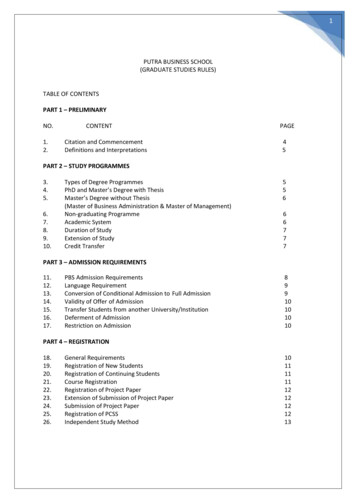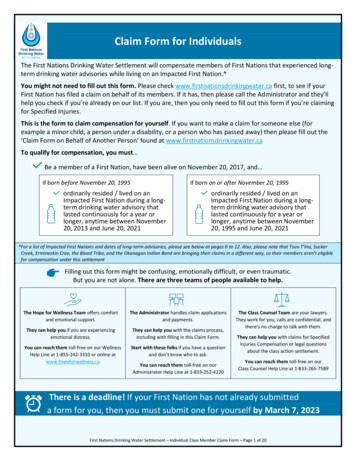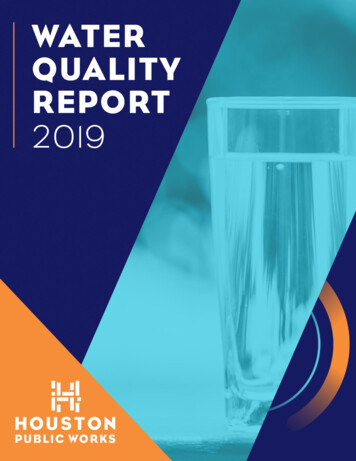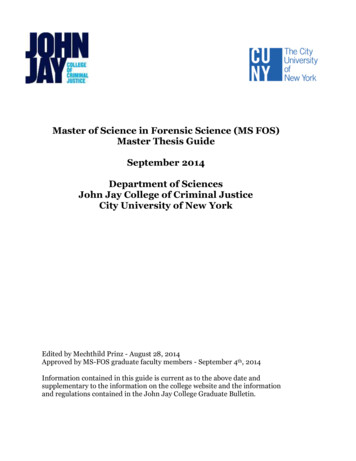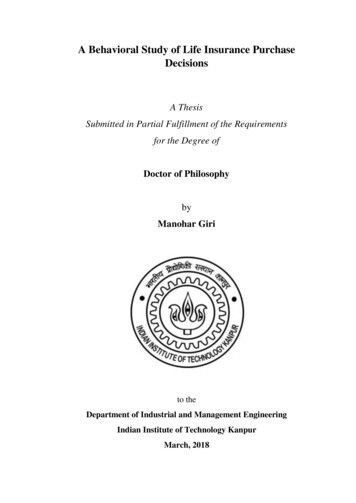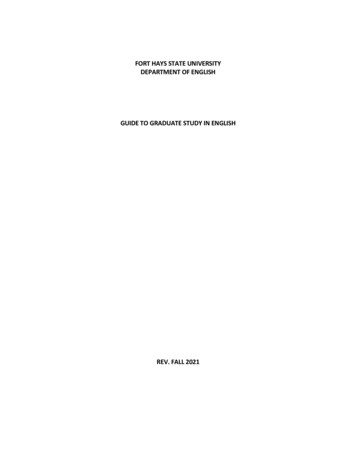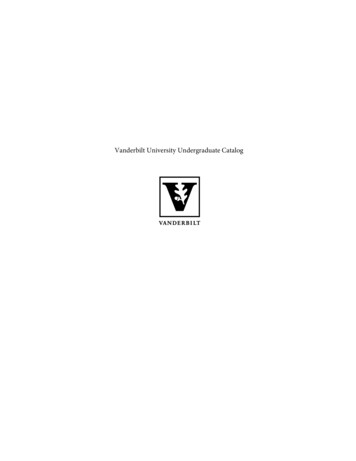
Transcription
MASTER THESISAccess to Drinking Water and Stakeholder Action Drinking Water Governance in Cameroon from aPolitical-Ecological PerspectiveCase Study: Upper Mefou Watershed, CameroonSubmitted byWibke OttMarchlewskistraße 2810243 BerlinWibke.Ott@gmx.deBorn on: 26/05/1988Student Number: 4200429Freie Universität Berlin, Department for Geographical Development StudiesSummer Semester 20141st Examiner: Prof. Dr. Dörte Segebart2nd Examiner:Prof. Dr. Theo Rauch
!!!!!!!!!!!!!!
AcknowledgementAcknowledgementAt this point, I wish to thank several people who have supported me to finalizethis master thesis.I would like to thank the project « Enhancing collaborative research and development capacities of German and African Partners on Integrated WatershedManagement (IWM R&D CB)” for the infrastructural as well as financial support.My special appreciation and thanks go to my advisors Professor Dr Dörte Segebart and Professor Dr Theo Rauch, whose work have shown me the multidimensional strategy to the development context and for the constructive andhelpful supervision of my master thesisFurthermore, I would particularly like to express my gratitude to the wholeIWM R&D CB project team in Cameroon. My special thanks are addressed tothe Cameroonian project coordinators Professor Dr Jules Remy Ndam andRodrigue Aimé Feumba. Mr Fuemba never has left a question unanswered andencouraged me in the understanding of the Cameroonian drinking water context.At this point, I would like to thank the project involved master students aswell, namely Rufine Mbezele Atengana, Alain Tchamagam and Melissa GandjeMgbatou. Cardinal thanks are addressed to Phd student Mr Olivier Zogningand Mr Ronald Kongue for the great support during the fieldwork and implementation of household interviews. I would also like to mention SalomonCésar Nguemhe Fils for his support during my stay in Cameroon. Last but notleast, I would like to express my gratitude to Charlotte Wilczok for an excitingfield stay in Cameroon and animated discussions, my sister Antje Ott, my parents Carsta and Achim Ott and my friends Julia Zill and Marika Wilczok.Wibke Ott, July 2014I
II
AbstractAbstractCameroon faces various challenges. One of them is the problem of access tosafe and sufficient drinking water under acceptable, assessable, socially andeconomical affordable and equitable circumstances. Under the defined understanding of Drinking Water Governance the thesis analyzes the international,national and local institutional structures, conditions as well as stakeholdersregarding the drinking water management in Cameroon. The objective is a holistic presentation of the strengths (S), weaknesses (W), opportunities (O) andthreats (T) in the Drinking Water Governance in Cameroon. The field researchhas been conducted from March till June 2013 and is covered in the situationanalysis of the thesis.III
Table of ContentsTable of ContentsAcknowledgement . I!Abstract . III!List of Figures . IX!List of Tables . XII!List of Boxes . XIV!Abbreviations . XVI!1! Introduction and Objective . 1!1.1! Research Background and Motivation . 2!1.2! Aim and Posing Question . 2!2! Theory .6!2.1! Political Ecology . 6!2.2! Drinking Water Governance . 8!3! Methodological Approach and Analytical Framework. 12!3.1! Field Methods . 12!3.1.1! Expert Interviews . 13!3.1.2! Household Interviews . 14!3.1.3! Observations . 15!3.2! Analytical Framework: SWOT Analysis based on Political Ecology andDrinking Water Governance . 16!3.3! Critical Reflection . 19!4! Analysis International Level: . 21!4.1! Institutional Structures & Stakeholders influencing the Drinking WaterGovernance in Cameroon . 21!4.2! Global Conventions & Aims . 21!4.3! Neoliberal Interests in Drinking Water Governance . 25!4.3.1! Privatization. 26!4.3.2! Decentralization . 28!4.4! International Stakeholders in the Drinking Water Governance . 29!4.5! Critical Reflection . 31!5! Analysis National Level: . 35!V
Table of Contents5.1! Conditions & Institutional Structures influencing the Drinking WaterGovernance from Outside the Drinking Water Sector inCameroon . 35!5.1.1! Ecological Conditions: Location, Climate and Fresh WaterResources in Cameroon. 35!5.1.2! Political Conditions . 38!5.1.3! Socio-Economical Conditions . 42!5.1.4! Critical Reflection . 45!5.2! Institutional Structures influencing the Drinking Water Governance fromInside the Drinking Water Sector in Cameroon . 47!5.2.1! Privatization and Decentralization in the Drinking WaterGovernance . 47!5.2.2! Policies and Water Legislation . 48!5.2.3! Vision 2035, PRSP and GESP . 49!5.2.4! IWRM Process . 51!5.2.5! International Agreements . 53!5.2.6! Rural and Urban Water Supply Strategy . 53!5.2.7! Critical Reflection . 54!5.3! Stakeholders in the Dinking Water Governance in Cameroon . 55!5.3.1! The Big Three: State, Public and Private Water Companies . 56!5.3.1.1 MINEE .56!5.3.1.2!CamWater . 60!5.3.1.3 CDE . 62!5.3.2! International Donors . 64!5.3.3! Civil Society . 67!5.3.4! Critical Reflection . 69!6! Analysis Local Level – Case Study Upper Mefou Watershed. 71!6.1! Conditions and informal institutional structures in the Upper MefouWatershed . 71!6.2! Access to Drinking Water . 77!6.3! Example of the Mefou Dam Reconstruction for Drinking WaterProvision . 80!6.4! Critical reflection . 85!7! Result Analysis and Discussion . 88!7.1! Evaluation of Drinking Water Governance Components in Cameroon 94!7.2! The SWOTs of the Drinking Water Governance in Cameroon . 97!7.3! Outlook . 97!VI
Table of ContentsA! Attachment . XCVIII!A.1! Figures . XCIX!A.2! Tables . CIV!A.3! Data CD. CVIII!List of Literature .CIX!VII
List of FiguresList of FiguresFigure 3–1:! Analysing Framework of Drinking Water Governance . 17!Figure 3–2:! The Four Components of the Drinking Water Governance inCameroon. 18!Figure 4–1:! Steps towards international Cooperation concerning DrinkingWater. 24!Figure 5–1:! Climate Zones Cameroon . 37!Figure 5–2:! Political System of Cameroon. 41!Figure 5–3:! Poverty Rate 2001 & 2007; Mode of Employment . 44!Figure 5–4:! GESP as National Master Plan for all Sectors, including WaterSector . 50!Figure 5–5:! Main Stakeholder in the Drinking Water Sector in Cameroon . 56!Figure 5–6:! Organizational Chart MINEE . 58!Figure 5–7:! Demonstration with Buckets and Cans organized by DC on 22ndMarch 2013 . 69!Figure 6–1:! The Study Area at Local Level: The Upper Mefou Watershed . 72!Figure 6–2:! Village Ekong. Mr Mbaye taking care of the Pluviometer . 73!Figure 6–3:! Road Conditions in the Upper Mefou Watershed . 74!Figure 6–4:! Villages and Numbers of HH in the Upper Mefou Watershed . 75!Figure 6–5:! (R) House out of Loam in Etoud; (L.) House out of Stone inNouma. . 76!Figure 6–6:! Budget of a Villager per Day in the Upper Mefou Watershed . 77!Figure 6–7:! The Water Level of the Mefou on 10th March and 16thApril 201381!Figure 6–8:! Construction Work close to the Mefou Dam in the villageMinkoameyos . 83!Figure 7–1:! Conditions, Structures & Stakeholders in the Drinking WaterGovernance in Cameroon . 89!Figure A–1:! Cameroonian IWM Project Team . XCIXFigure A–2:! The Six Main Watersheds in Cameroon . CFigure A–3:! Deforestation in the Upper Mefou Watershed . CIFigure A–4:! Cloth Washing in a Tributary of the Mefou Dam . CIFigure A–5:! Fieldwork with CamWater TAU in the Upper Mefou Watershed. CIIFigure A–6:! GPS Detection of the Upper Mefou Watershed by Moto . CIIFigure A–7:! Reconstruction of the Pipe System from Nkolbisson till theWater Treatment Station Messa by the private Ger-manCompany Pfeiffer. CIIIIX
List of FiguresX
List of TablesList of TablesTable 4-1:! Dublin Principles . 22!Table 4-2:! IWRM Principles . 22!Table 4-3:! Pros and Cons of Water Privatization . 27!Table 4-4:! Four different Aspects of Decentralization . 28!Table 4-5:! Global Civil Society in the Drinking Water Sector . 29!Table 5-1:! Legislative Election Results from 23rd September 2013 . 37!Table 5-2:! Classification of Corruption . 40!Table 5-3:! Economical Basic Information. 45!Table 5-3:! Vision 2035 and National Strategies concerning Drinking Water inCameroon . 51!Table 5-4:! Summary of the Rural and Urban Water Strategy . 54!Table 5-5:! Ministries involved in the Water Sector in Cameroon . 56!Table 6-1:! Drinking Water Access Resources . 78!Table 6-2:! Implementer of the Water Resource . 78!Table 6-3:! The Human Right to Water Indicators in the Upper MefouWatershed . 80!Table 6-4:! Stakeholders in the Mefou Dam Rehabilitation . 82!Table 6-5:! Profit and Loss of the Activation of the Mefou Dam . 85!Table 7-1:! Benchmark of elaborated component associated indicators . 94!Table 7-2:! Assessment of Drinking Water Governance Components andIndicators . 96!Table 7-3:! SWOT Analysis of the Drinking Water Governance in Cameroon. 95!Table A-1:! List of Expert Interview Partners .CV!Table A-2:! Contract Forms of PPP .CV!Table A-3:! Key Dates in the Reformation of the Drinking Water Sector CVII!XII
List of BoxesList of BoxesBox 1:!Trends in Governance and (Drinking) Water Governancereforms . 9!Box 2:!Key Elements of Good Governance and GovernancePerformance . 10!Box 3:!What does Sufficient, Safe, Acceptable, Accessible and AffordableAccess to Water Wean?. 22!Box 4:!Washington Consensus & SAP . 24!Box 5:!TYP-1 & TYP-2 Partnership . 28!Box 6:!Legislative Elections in Cameroo . 37!Box 7:!Definition Corruption . 40!Box 8:!The Political Willingness in Cameroon . 56!Box 9:!Capacity of the former company SNEC . 58!Box 6:!Three Steps in the Rehabilitation of the Mefou DamRehabilitation Project . 80!XIV
AbbreviationsAbbreviationsADBAsian Development BankAEDAfrican Election DatabaseAFDFrench Agency for DevelopmentAfDBAfrican Development BankBMZBundesministerium für wirtschaftliche ZusammenarbeitbpbBundeszentrale für politische BildungCASCountry Assistance StrategyCSPCountry Strategy PaperCPDMCameroon People’s Democratic MovementCTPLCommission Technique de Privatisation et de LiquidationDCDynamique CitoyenneEBRDEuropean Bank for Reconstruction and DevelopmentECBEuropean Central BankECCASEconomic Community of Central African StatesECOSOCEconomic and Social CouncilEIBEuropean Investment BankEngEnglishFrFrenchGDPGross Domestic ProductGIIGender Inequality IndexGESPGrowth and Employment Strategy PaperGMGGaya Media GroupGTIGerman Trade & InvestmentGWPGlobal Water PartnershipGWP-CmrGlobal Water Partnership CameroonHDIHuman Development IndexICWEInternational Conference on Water and the EnvironmentIFESInternational Foundation for Electoral SystemsIFPRIInternational Food Policy Research InstituteIWRMIntegrated Water Resource ManagementJMEJournée Modial de l‘Eau, Eng International Water DayLPSHULettre de politique sectorielle de l’hydraulique urbaineMDGMillennium Development GoalsMDRMovement for the Defence of the RepublicMINADERMinistry of Agriculture and Rural DevelopmentMINATDMinistry of Territorial Administration and DecentralizationMINCOMMERCE Ministry of CommerceMINEEMinistry of Water and Energy, Fr Ministère de l‘Eau et de l‘EnergieMINEPMinistry of Environment and the Protection of NatureXVI
AbbreviationsMINEPATMinistry of Economy, Planning and Regional DevelopmentMINEPIAMinistry of Livestock, Fishery and AnimalMINFIMinistry of FinanceMINHUDMinistry of Housing and Urban DevelopmentMINIMIDTMinistry of Mine, Industry and Technological InnovationMINRESIMinistry of Scientific Research and InnovationMINREXMinistry of International RelationshipsMINSANMinistry of Public HealthMRCRenaissance MovementNWCNational Water CommitteePAEPARWater Supply and Sanitation Program in Rural AreasFr Programme d’Approvisionnement en Eau Potable et Assainissement en milieu RuralPANGIRENational Integrated Water Resource Management PlanPAWD-IISecond Phase of the Partnership for Africa’s Water DevelopmentPDUEUrban and Water Development ProjectPFPPolicy Framework PapersPMPrime MinisterPNDPNational Participative Development ProgramFr Programme National de Developpement ParticipatifPRSPPoverty Reduction Strategy PaperPRCPresidency of the Republic of CameroonPSPPrivate Sector ParticipationSDFSocial Democratic FrontSNECNational Water Company of CameroonFr Société Nationale des Eaux du CamerounTAUTechnical Assistance UnitTITransparency InternationalTWCTransnational Water CorporationUDCUnion for Democracy and ChangeUMWUpper Mefou WatershedUNESCO-IHEUnited Nations Educational, Scientific and Cultural Organization - Institute for Water EducationUNDPUnited Nations Development ProgramUNDP1National Union for Democracy and ProgressUNDP WGFUNDP Water Governance FacilityUNW-DPACUN-Water Decade Program on Advocacy and CommunicationWDMWorld Development MovementWSPWater and Sanitation ProgramWSSWater Supply & SanitationWWCWorld Water CouncilWWFWorld Water ForumXVII
AbbreviationsYVEYoung Volunteer EnvironmentXVIII
Introduction and Objective!!1Introduction and ObjectiveWater is conceptualized on the one hand by its physical flow and on the otherhand by rules, social practices and political and socio-economic aspects (BAKKER2003). Further, water is “a symbol of identity, power and citizenship”(MOSSE 2008:948) and according to GRAEFE (2006) drinking water is a symbolof power demarcation. Therefore the management of drinking water is not justinfluenced by natural or scientific-technical factors; it is also highly influencedby society as well as social relations of power and culture (CONCA 2006; MOSSE2008; TRUELOVE 2011 CF. HEYEN ET AL 2006). The “[ ] links between control and access to water and social relations of power [ ] are neither socially,nor ecologically neutral (TRUELOVE 2011:144 CF. SWYNGEDOUW ET AL. 2002).In addition to it, the access to water in the Global South may distinguish fromgender (O’REILLY ET AL. 2009) and intra-community and intra-household differences, which correlate with labour, health problems and (illegal) practice toobtain water (TRUELOVE 2011). Unequal access possibilities to drinking waterremain a problem also for post 2015 MDGs. Globally it became clear that theallocation of fresh water in most areas is less a problem of physical water scarcity than more a problem of economical water scarcity. Mismanagement andpoor governance lay at the heart of the world’s water crisis (ROGERS & HALL2003). The governance of available drinking water resources becomes a keyissue to achieve water security at local, national and international level (UNDP2013B). ROGERS & HALL (2003) states effectiveness of water governance is inmany places of the world undermined by poor management, corruption, lackof appropriate institutions, bureaucratic inertia, insufficient capacity and shortage of investment. The same in Cameroon: Cameroon is the second country inAfrica (after the Democratic Republic of Congo) in terms of quantity of “available” water resources, estimated to be three times the world’s average (7,000m3), but the access to water still remains a scarce resource because of inadequate management practice (MAFANY & FANTONG 2006). This is a consequence of missing formal and cohere water policy, poor infrastructure andmaintenance of it as well as a weak uncoordinated institutional frameworkcomposed out of a multitude of stakeholders with low human and financialcapacity (GWP 2009D, 2010; CONFERENCES: JME 22.03.2013 & PANGIRE1
Introduction and Objective!!16.04.2013). The question, which was guiding the research, is what are thecauses of that situation and what are the conditions, structures, stakeholdersand interrelations promoting the mismanagement and insufficient access todrinking water. The answer goes back to historical influence, power relatedissues, theory and practice of legal situation, the proportion of formal and informal institution, stakeholder interests, capacities, willingness as well as powerfrom the international, national and sub-national level.1.1Research Background and MotivationThe research is realized through a DAAD financed program “Welcome to Africa” in the framework of a cooperation project “Enhancing collaborative research and development capacities of German and African Partners on Integrated Watershed Management (IWM R&D CB)“. It is a project in cooperation with the Freie Universität Berlin (Germany), United Nations University(Germany), Kenyatta University (Kenya), University of Cape Town (South Africa), University Yaoundé (Cameroon) and the consultancy IWM Expert. Theoverall objective of this project aims at strengthening information andknowledge transfer among the different stakeholder groups with regard toIWM. German students, graduates and young academics are sent to one of thementioned African universities for a study or research stay. The fieldwork forthis research took place in Cameroon in collaboration with the department ofGeography at the University of Yaoundé I.1.2Aim and Posing QuestionBased on the described problem of the lacking provision and access to drinking water in Cameroon the research focused on the structures and stakeholdersin the related sector to create a knowledge base, which is afterwards tried to beanalyzed under self-defined components and indicators of Drinking WaterGovernance (DWG). The final objective is to identify the strengths (S), weaknesses (W), opportunities (O) and threats (T) (SWOT) in the functional chainof the Drinking Water Governance in Cameroon. Thereby the research tries toapproach the topic from a holistic perspective, which contributes to understand the SWOTs in the DWG in Cameroon.2
Introduction and Objective!!The analysing framework divides the research into tow main components. Thefirst one is the Situation Analysis (1) focusing on the conditions, institutionalstructures and stakeholders on three levels - international, national and localone in the DWG in Cameroon. Each level is discussed in a single chapter(chapter 4 till 6). The second steps is the Result Analysis (2) subdivided in theassessment of the elaborated DWG components (2.1) as well as the strengths,weaknesses, opportunities and threats elaboration of the Drinking Water Governance in Cameroon (2.2) (Figure 3–1).The aim of the international chapter 4 is to present the global scope of actionin which the Cameroonian Drinking Water Governance is embedded. Subsequently the national context is analysed in chapter 5 subdivided into: conditions and structures from inside and outside the water sector as well as stakeholders influencing the DWG in Cameroon. Then the local level is examinedin chapter 6 by the case study of the Upper Mefou Watershed (UMW).The chapters’ three till six are each concluded with a sub-chapter called criticalreflection. The focal point is on the power related issues, interests, capacitiesand governance structures rather than on chemical, hydrological and technicalissues of drinking water like a multitude of researchers (e.g. MAFANY2006; JALBAET AL.2010, AJEAGAH 2013, DUNNAET. ALET AL.2014) is doing it,which take benefit from a more detailed look into the stakeholders’ interestsand strategies.The research is guided by the following questions:1) What are the causes of the technical and man-made inducted problems inthe access to drinking water in Cameroon?2) What are the influencing conditions and formal and informal institutionalstructures in the Drinking Water Governance in Cameroon on international, national and local level?3) Who are the stakeholders in the Drinking Water Governance in Cameroonand what are their range of actions, interests, capacities and interpenetrations?3
Introduction and Objective!!4) Based on research question two and three, how far are the elaboratedDrinking Water Governance components applied in Cameroon? Consequently, what are the SWOTs of the Drinking Water Governance?4
Theory!!2TheoryFor many decades the wide social and political processes, which are involved inwater systems, were ignored in research (MOSSE 2008; NUSCHLER 2009). Likewise, a growing literature on international relations in water crisis neglectedwater social embeddedness to a great extent (RENNER 1989; GLEICK 1993; DEVILLIERS 1999; KLARE 2001; GLEICK 1998; JURY&VAUX 2007). To address thisgap recent geographical approaches conceptualize the complexity and relationsof water systems with culture, economy, ecology, history, policy and societyorganizations (METHA 2005; METHA ET AL 2007; FONTEIN 2007; MOSSE 2008;BECKEDORF 2010). One of them is Political-Ecology, an interdisciplinary multi-dimensional research approach that tries to address this complexity and applies the nexus of resources, politics and social sciences (KRINGS 2008). Animportant topic of the Political-Ecology is the privatization of the drinking water supply accompanied with on-going decentralization reforms (SWYNEGEDOUW ET AL.2002; SWYNGEDOUW 2005; KEIL & BOURDREAU 2006;KRINGS 2008; LIEB 2013), both are comprised concepts of a neoliberal drive inthe (drinking) Water Governance (BAKKER 2007; KRINGS 1999, 2008; MOSSE2008). This development becomes apparent in the Drinking Water Governance in Cameroon. This chapter presents the Political-Ecology approach andDrinking Water Governance, which compose the main components of theanalytical framework of this research (see sub-chapter 3.2).2.1Political EcologyWater Governance regarding drinking water calls for a multidimensional approach. The understanding of Political Ecology as a multidimensional approach at the nexus of political, nature and social science (KRINGS 2008;RAUCH 2009; ZIMMER 2010B) will be used for the analysis in this research. Dependent on the literature Political Ecology is labelled as a approach or theory.Fountainhead ofPolitical EcologyBLAIKIE (1985) and BLAIKIE & BROOKFIELD (1987) mainly developed the Political Ecology by introducing the so-called “Third World Political Ecology” asthe first field of research of Political Ecology (KRINGS 2007). In the Germanspeaking geography it was mainly introduced by GEIST (1992, 1999) andKRINGS (1996, 1999, 2000, 2008). The approach has its roots in the critique of6
Theory!!quantitative, one-dimensional and apolitical environment research since the1980ties and is nowadays a dominated field in geographical studies on development (WALKER 2005; KRINGS 2008; BECKEDORF 2010; ZIMMER 2010B). Amultitude of scientists and researchers (e.g. KRINGS 2000; KRINGS 2008;BLAIKIE 1999; BAKKER 2007; COY & NEUBURGER 2008; HARTWIG 2008;BECKEDORF 2010) have dealt with this approach.Central conceptPolitical Ecology implies an examination of natural resources and power relations between different actors, which entitles winners as well as lose
MASTER THESIS Access to Drinking Water and Stakeholder Action - Drinking Water Governance in Cameroon from a Political-Ecological Perspective Case Study: Upper Mefou Watershed, Cameroon Submitted by Wibke Ott Marchlewskistraße 28 10243 Berlin Wibke.Ott@gmx.de Born on: 26/05/1988 Student Number: 4200429
